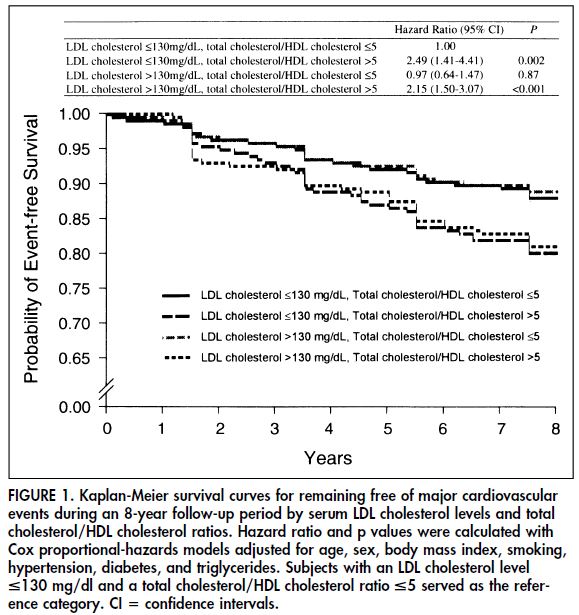A post on the Chinese Study I referred to on my last FB item; I thought this Chinese piece was a well-executed effort, that yet again illustrated the key role of ratios in determining risk, and the dangers with inference from Tot Chol and/or LDL-C. In the absence of a particle count to determine LDL-P, the ratios are pivotal; discordance between LDL-C and LDL-P is a major issue, speaks to the mechanisms of Insulin Resistance (hence importance of assessing Trig/HDL also), and needs to be fully internalised by anyone considering technical path forward for specific cases. And so the study:
“Efficacy of Cholesterol Levels and Ratios in Predicting Future Coronary Heart Disease in a Chinese Population”
Rather than summarising on behalf of the team, I’ll let their summary speak for itself:
“The total cholesterol/high-density lipoprotein (HDL) cholesterol ratio was the most powerful lipoprotein predictor of future CHD (hazard ratio 1.21 for a 1.0 increment in ratio; p <0.001). Subjects with “highrisk” LDL cholesterol levels (>160 mg/dl) and low total cholesterol/HDL cholesterol ratios (<5) had an incidence of CHD similar to those with low levels of both LDL cholesterol (<130 mg/dl) and total cholesterol/HDL cholesterol ratios (4.9% vs 4.6%).
In contrast, subjects with “low-risk” LDL cholesterol levels (<130 mg/dl) and high total cholesterol/HDL cholesterol ratios (>5) had a 2.5-fold higher incidence of CHD than those with similar LDL cholesterol levels but low total cholesterol/HDL cholesterol ratios (p <0.001). Compared with using an LDL cholesterol level of 130 mg/dl as the cut-off point, using a total cholesterol/HDL cholesterol ratio of 5 was associated with superior specificity (73% vs 59%, p <0.001) and accuracy (72% vs 58%, p <0.001), and similar sensitivity (50% vs 53%). Our data indicate that current guidelines for lipid management may misclassify subjects with high levels of HDL and LDL cholesterol as well as those with low levels of HDL and LDL cholesterol. Using the ratio of total to HDL cholesterol as the initial screening tool can obviate this discrepancy. 2001 by Excerpta Medica, Inc. (m J Cardiol 2001;88:737–743)
I concur. Another observation by the team was:
“It is noteworthy that all published primary-prevention or secondary-prevention lipid-intervention trials included patients with an average total cholesterol/HDL cholesterol ratio in excess of _5.16–18,22,24,25 However, the average level of total cholesterol/HDL cholesterol ratio in Western populations is only 4.5.12 . Why there was such a discrepancy is still uncertain.
The above is an exceedingly interesting observation; the group with total cholesterol/HDL cholesterol ratio in this study was the one with the very high risk as described – so it is entirely appropriate that trials would focus on such populations. But, as often pointed out, the trial inferences should be applied back to the TYPE of population that the trial actually represented. Which means that total / HDL should be a primary metric used to deploy the solutions discovered in the trials. Is this the case? Depends on the deployer – but I haven’t come across much discussion of these ratios outside of the research world, and wonder if the current risk guideline algorithms adequately incorporate this insight? I guess they will do indirectly anyway by accommodating the risk factors that will track with Tot/HDL somewhat. In any case, I haven’t studied the guidelines really, rather focus on the science, but perhaps someone knowledgeable could comment?
Finally, below an excerpted graph from the study itself to illustrate it’s outcome – very similar to Nigel’s one from Dayspring, which tells the same story but from Framingham’s data. Hard to make out linetypes, so see table at top – Ratio trumps LDL-C decisively for the key high-risk subset.
will post separately on the profiles of F.Hypercholesterolemia candidates; due to LDL receptor and other genetic issues, some heterozygous types have HDL-C around 30 mg/dL, and LDL-C around 260 mg/dL, again ratio is a revealing metric here…








